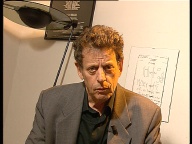 |
 |
Interview
BiographyPhilip Glass is widely recognised as one of the leading figures of the international music scene of the last twenty years. His output ranges from opera to dance music, to film scores and music for the theatre. Born in Baltimore on January 31 1937, he began studying the violin at six years old and became serious about music when he took up the flute at eight. But by the time he was 15, he had become frustrated with the limited flute repertoire as well as with musical life in post-war Baltimore. During his second year in high school, he applied for admission to the University of Chicago, where he majored in mathematics and philosophy, and in his free time practiced the piano and concentrated on such composers as Ives and Webern. At 19, Glass graduated from the University of Chicago, determined to become a composer, and moved to New York and the Juilliard School. By then he had abandoned the 12-tone techniques he had been using in Chicago and preferred American composers like Aaron Copland and William Schuman. By the time he was 23, Glass had studied with Vincent Persichetti, Darius Milhaud, and William Bergsma. He had rejected serialism and preferred such maverick composers as Harry Partch, Ives, Moondog, Henry Cowell and Virgil Thomson, but he still had not found his own voice. Still searching, he moved to Paris and two years of intensive study under Nadia Boulanger. He was hired by a film-maker to transcribe the Indian music of Ravi Shankar in notation readable to French musicians. In the process, he discovered the techniques of Indian music. Glass promptly renounced his previous music. After researching music in North Africa, India, and the Himalayas, he returned to New York, and began applying Eastern techniques to his own work. By 1974, he had composed a large collection of new music, not only for use by the theater company Mabou Mines (Glass was one of the co-founders of the company), but mainly for his own performing group, the Philip Glass Ensemble. This period culminated in Music in 12 Parts, a three-hour summation of Glass' new music, and reached its apogee in 1976 with the Philip Glass/Robert Wilson opera Einstein on the Beach, thefour and a half hour epic now seen as a landmark in 20th-century music-theater. Glass' output since Einstein has ranged from opera (Satyagraha, Akhnaten, The Making of the Representative for Planet 8, The Fall of the House of Usher, The Juniper Tree, Hydrogen Jukebox) to film scores (Koyaanisqatsi, Mishima, The Thin Blue Line, Powaqqatsi, A Brief History of Time, and Candyman) to dance (A Descent into the Maelstrom and In the Upper Room), and such unclassifiable theatre pieces as The Photographer, 1000 Airplanes on the Roof, and The Mysteries and What's so Funny?. Among his recently completed works are Itaipu, a large-scale work for chorus and orchestra; The Low Symphony, based on David Bowie's album 'Low'; Symphony No. 2, commissioned by the Brooklyn Philharmonic; The Voyage, a centennial commission from the Metropolitan Opera; Symphony No. 3 ,commissioned for the Stuttgart Chamber Orchestra; The Witches of Venice , a ballet created by Beni Motressor and commissioned by Teatro alla Scala and three compositions based on the works of Jean Cocteau, Orphée, La Belle et La Bête, and Les Enfants Terribles. Current projects include three collaborations with Robert Wilson: White Raven, an opera commissioned by Portugal to celebrate its history of discovery, Monsters of Grace, a music/theater work with the Philip Glass Ensemble and TSE, a music theater installation. |
|||
| Glass has received honorary degrees from the University of Brandeis, the Philadelphia University of the Arts, and New York University. In 1995 he was nominated chevalier des arts et des lettres by the French government. |  |
